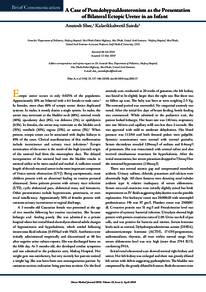Document
A case of pseudohypoaldosteronism as the presentation of bilateral ectopic ureter in an infant.
Contributors
Saieda, Kalarikkalveetil., Author
Publisher
Oman Medical Specialty Board.
Gregorian
2010-04
Language
English
English abstract
Ectopic ureter occurs in only 0.025% of the population. Approximately 10% are bilateral with a 6:1 female to male ratio.1 In females, more than 80% of ectopic ureter drains duplicated systems. In males, it mostly drains a single system. In males, the ureter may terminate at the bladder neck (48%), seminal vesicle (40%), ejaculatory duct (8%), vas deferens (3%), or epididymis (0.5%). In females, the ureter may terminate at the bladder neck (35%), vestibule (30%), vagina (25%), or uterus (5%).1 When present, ectopic ureter can be associated with duplex kidneys in 85% of the cases. Clinical manifestations of this malformation include incontinence and urinary tract infections.2 Ectopic termination of the ureter is the result of the high (cranial) origin of the ureteral bud from the mesonephric duct. The delayed incorporation of the ureteral bud into the bladder results in ureteral orifice to be more caudal and medial. A sufficient tunnel length of the sub mucosal ureter is the most important component of Vesico ureteic obstruction (UVJ). Being asymptomatic, most children present with an abnormal finding on routine prenatal ultrasound. Some patients present with urinary tract infection (UTI), cyclic abdominal pain, abdominal mass, and hematuria. Other presentations include hypertension, proteinuria, or even renal insufficiency. Approximately 50% of females.
Member of
Resource URL
Citation
Shee, Anutosh, & Saieda, Kalarikkalveetil (2010).A case of pseudohypoaldosteronism as the presentation of bilateral ectopic ureter in an infant. Oman Medical Journal, 25 (2), 137-140.
Category
Journal articles

